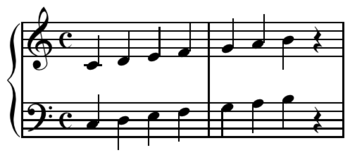Barline
The barline or dividing line is a sign used in musical notation represented as a vertical line that crosses the staff or staffs (in systems) separating the bars. In the scores or scores, the bar lines serve as an organization method that contributes to a better orientation.
History
The origin of the dividing lines dates back to the XVI century, according to Pérez Gutiérrez and Michels although they are not used systematically but after the XVIIth century. On the other hand, from the 17th century onwards it begins to mean that the note immediately after the bar «configures a center of gravity".
According to De Candé since the XIII century, vertical bars are used to indicate pauses. However, the use of the barline, as well as the dot, as we understand them today began between the end of the XIV century and the 16th century.
Description
These are the vertical lines drawn across the staff to mark the bars. Normally these bars extend vertically between the extreme lines of the staff, that is, between the first line and the fifth line. However, it can sometimes extend across several staves constituting a system barline. This occurs for example when the joined staves belong to the same instrument such as the piano or an instrumental ensemble.
Types
In sheet music we can find several types of barlines (see Figure 1):
- bar of simple compass.
- double compass bar.
- music start bar.
- End music bar.
- repeat start bar.
- repeat end bar.
Simple bar
In music with a regular time signature, the function of the bars is to indicate a periodic agogic accent in the music, regardless of its duration. In music written in mixed time, bars are used to mark the beginning of groups of rhythmic notes. But this is subject to great variations. Some composers use dotted barlines, the rest including Hugo Distler place barlines in different places on the various voices or parts to mark widely varying groupings from one voice to another.
"The dividing bar is much, much more than a mere accent and I don't think it can be simulated by an accent, at least not in my music. »Igor Stravinsky
Slashes also indicate grouping: the rhythmic beats within and between barlines, within and between phrases, and at higher levels such as meter. The single slash indicates the start of the staff
Double slash
A double bar can be represented in two different ways as (see b and c signs in Figure 1):
- Formed by two fine lines drawn very together. This sign serves to separate two sections into one piece. They are also used when there is a change in key armor, compass or substantial changes in style or Tempo.
- Formed by a fine line followed by a thick bar. For its part, this symbol is usually used to signal the beginning and end of a piece or movement.
Repeat bar
The slash that is used as a repeat sign is similar to the double slash that indicates the end of a piece. But the repeat bar also has two dots placed one on top of the other. The repeat end bar indicates that the musical section written immediately before this sign will be repeated. The beginning of the repeated passage can be marked with a repeat start slash. Although, in the event that this sign does not appear, it is understood that the repetition must be carried out from the beginning of the piece or movement. If the repeat start barline appears at the beginning of a staff, its function is to indicate the beginning of the passage to be repeated.
Contenido relacionado
Symphony No. 3 (Dvořák)
Salzburg
Welcome to the Future 3






